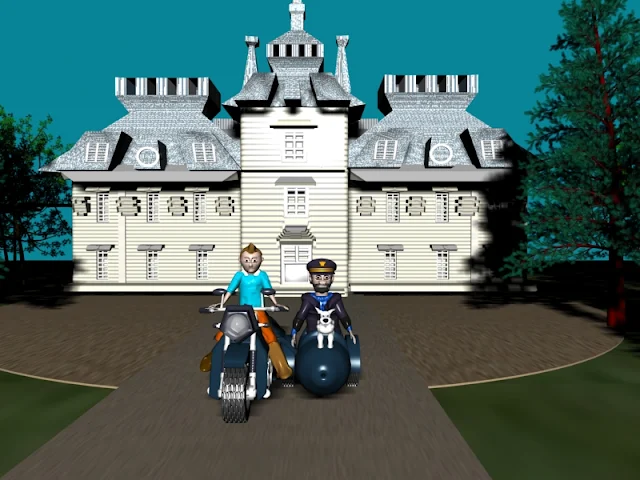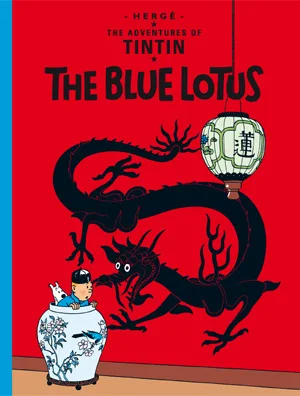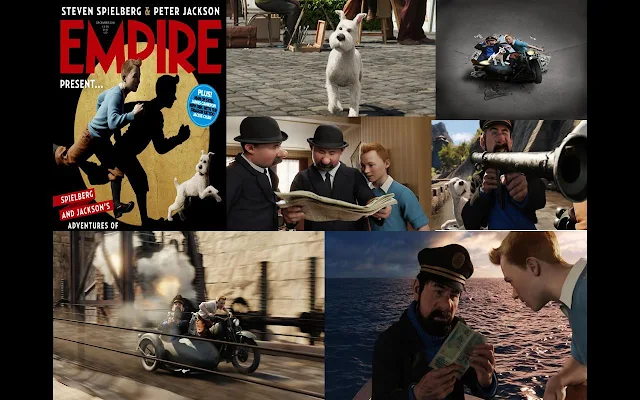 |
| 3D Picture of Tintin and His Famous Dog Snowy . Created by me (Manash Kundu) |
Hergé More: Creator of Tintin
Date of Birth
22 May 1907,
Brussels, Belgium
Date of Death
3 March 1983,
Brussels, Belgium (pulmonary failure)
Birth Name
Born
under the name Georges Remi on May 22, 1907 in Brussels, Belgium. As a child,
Herge had a gift for drawing but never had any formal training in the visual
arts. He attended both school and the boy scouts during the World War 1 and
post-World War 1 Era. After he finished school Herge published his first ever
cartoon: "The Adventures of Totor" for Le Boy-Scout Belge (a scouting
magazine).
In 1928,
he became in charge of the producing material for Le Petit Vingtieme (The
Little Twentieth) a youth supplement newspaper. He began illustrating "The
Adventures of Flup", "Nenesse", "Poussette",
"Cochonnet", etc. January 10, 1929, Herge introduced a cartoon about
a traveling Belgium reporter (Tintin) accompanied by his fox terrier (Snowy)
traveling the Soviet Union. By 1930, Herge published the very first Tintin
book: "Tintin in the Land of the Soviets". Tintin soon became Herge's
"ligne Claire" (French for clear line) legacy.
The later
adventures of Tintin involved other locations of the world from China all the
way to America. Within the next 50 years Tintin became one of the most popular
European comics of the 20th Century, due to its well-researched plots,
appealing characters, humor, political thrillers, & real world settings.
After completing 23 books, Herge passed away on March 3, 1983, leaving
"Tintin & the Alpha-Art" (The 24th book) unfinished. Despite
Herge not being able to give his Tintin series the proper end, all of his works
along with Tintin will continue to inspire artists and enchant readers from the
years to come.
Childhood
of Herge:
Georges
Prosper Remi was born at 7:30 in the morning of 22 May 1907 in his parents'
home in Etterbeek, Brussels, a central suburb in the capital city of Belgium.
His parents were middle class; his father, the Wallonian Alexis Remi, worked in
a candy factory, whilst his mother, the Flemish Elisabeth Dufour, was a
homemaker.They had been married on 18 January 1905, and moved into a house at
25, de la rue Cranz (now 33, rue Philippe Baucq), where Hergé would later be
born, although a year later they moved to a house at 34, rue de Theux. His
primary language was his father's French, but growing up in the bilingual
Brussels, he also learned how to speak Flemish, developing a Marollien accent
from his maternal grandmother.Like the majority of Belgians at that time, his
family belonged to the Roman Catholic Church, though were not particularly
devout. He would later characterise his life in Etterbeek as being dominated by
a monochrome gray, and would always remember it as having been extremely boring.
"My
childhood was extremely ordinary. It happened in a very average place, with
average events and average thoughts. For me, the poet's "green
paradise" was rather gray... My childhood, my adolescence, Boy Scouting,
military service – all of it was gray. Neither a sad boyhood nor a happy one –
rather a lackluster one."
Hergé.
It was in
these early years that Remi developed a love of cinema, particularly favouring
Windsor McCay's pioneering animated film Gertie the Dinosaur and the films
featuring Charlie Chaplin, Harry Langdon and Buster Keaton; his later work in
the comic strip medium would display an obvious influence from these early
films in style and content. Remi also immersed himself in literature, in
particular enjoying the novels of British and American authors, such as
Huckleberry Finn, Treasure Island, Robinson Crusoe and The Pickwick Papers.
Despite this preference for Anglophone works, he also read a number of French
novels, such as General Dourakine, Twenty Years After and The Vicomte of Bragelonne:
Ten Years Later.He took to drawing as a hobby, sketching out stories and scenes
from his daily life along the edges of his school books. Some of these
illustrations were of German soldiers, because his four years of primary
schooling at the Ixelles Municipal School No. 3 coincided with World War I
(1914–1918), during which Brussels was occupied by the German Empire.
 |
| Tintin and His Friends and Other Characters From Different Comics |
In 1920
his secondary education began at Saint-Boniface School, an institution
controlled by the archbishop where the teachers were Roman Catholic priests.
Aged 12, Georges joined the Boy Scouts troop of the school, where he was given
the totemic name "Renard curieux" (Curious fox).In 2007, an old
"strip" by Hergé was found on a wall of the school. His first drawings
were published in 1922 in Jamais assez, the school's Scout paper, and in Le
Boy-Scout Belge, the Scout monthly magazine.From 1924, he signed his
illustrations using the pseudonym "Hergé". His subsequent comicbook
work would be heavily influenced by the ethics of the Scouting movement, as
well as his early travel experiences with the scouting association.
Herge
Creation Tintin:
Tintin, a punk-haired teenage reporter and
super-sleuth, in 1929 in the children's supplement of the Belgian Catholic
newspaper "Le Vingtième Siecle." Tintin moved into his own magazine
in 1946. Twenty-three complete stories were produced, plus one story that was
incomplete at the time of Hergé's death. Tintin became the Belgian equivalent
of Mickey Mouse, popular in every country around the world except for the
United States.
 |
| Herge and his famous Cartoon Character Tintin (Idol) |
His
pseudonym is the French phonetic pronunciation of the letters "R" and
"G," taken from "Remi" and "Georges."
Directly
inspired a number of contemporary cartoonists, including Joost Swarte and
Dennis Tucker.
 |
| Threesome Awesome Tintin Haddock and Dog Snowy |
In 1989,
an Anarchist graphic novel titled "Breaking Free" was published in
Britain, featuring unauthorized appearances of Hergé's characters Tintin and
Captain Archibald Haddock as the main protagonists. The political propaganda
story is of Tintin and Haddock as Union laborers who join a revolutionary
movement that, at the novel's end, is about to topple the British government
(Hergé himself held very conservative political views and probably would have
been horrified by this). Since the book was intentionally published without
copyright, no legal action could be taken against the creators or publishers.
Was
inspired by Jules Verne's work.
"The
Adventures of Tintin" has been translated into more than 50 languages
around the world.
 |
| 3D Picture of Tintin Created by Me (Manash Kundu) With Herge and Comics Books |
Has
written & drawn a total of 23 complete and 1 incomplete volumes of
"The Adventures of Tintin" series.
 |
| Tintin and Haddock in my Facebook Group COFFE-HOUSE-ADDA |
Andy
Warhol and Roy Lichtenstein citing him as a strong influence on their work.
In 1982,
Belgian Society of Astronomy named a small planetoid, situated between Mars and
Jupiter, after him.
 |
| Imaginary 3D Picture of Tintin, Haddock and Dog Snowy on MotorBike in Front of Their Marlinspike Hall Created by Me (Manash Kundu) |
Didn't
draw Tintin's famous quiff until the second album. In the first album, Tintin's
hair was combed to the front, but during a chase scene in a vintage Mercedes
convertible, Tintin's hair flew back, thus giving him his trademark quiff.
 |
| Imaginary Cartoon Where Tintin Draw His own Creator Herge |
His
inspiration for his famous cartoon character "Tintin" came from the
adventures in 1928 of a young 15 year old Danish boy, later actor, Palle Huld
who won a contest in the newspaper "Politiken". The prize was an
around the world trip in the occasion of the centennial of author Jules Verne.
Palle Huld wrote a book about his marvelous trip; "Around the World in 44
Days with Palle" which became world famous and thus inspired Hergé.
Hergé
drew inspiration for his star character from the career of the French foreign
correspondent Albert Londres. A pioneer of investigative journalism, Londres
traveled the world to uncover the truth behind business, politics, governments
and the criminal underworld. Tintin represented the reporter that Hergé himself
would have liked to be An instant icon
 |
| 3D Picture of Tintin Created by Me (Manash Kundu) With Herge and Comics Books |
Tintin’s
features are simple: a round head, a button for a nose, two dots for eyes and a
quiff. This is the key to his success. He is flexible, distinctive yet
anonymous: any child or adult, of any age or culture, can identify with him.
Although
he starts out as an investigative reporter, Tintin develops into a detective.
Snowy and others regularly refer to him as Sherlock Holmes, and he has a good
deal of the famous English detective about him, including a sharp eye for
detail and considerable powers of deduction. Like Holmes, Tintin is a master of
disguise!
An
all-around expert
 |
| Imaginary 3D Picture of Tintin, Haddock and Snowy on Motorbike For New Adventure . Created by me (Manash Kundu) |
A bit
like James Bond, there is no car, motorcycle, locomotive, submarine, airplane,
helicopter, horse or camel that Tintin cannot drive, ride, steer or fly. In
Tintin in the Land of the Soviets, he carves an airplane propeller from a tree
using a pocketknife. In Cigars of the Pharaoh, he fashions a wooden trumpet
with which to communicate with the elephants. No matter what situation Tintin
finds himself in, he’s never at a loss for what to do.
 |
| Imaginary 3D Picture of Tintin, Haddock and Dog Snowy on MotorBike in Front of Their Marlinspike Hall Created by Me (Manash Kundu) |
Tintin
wholeheartedly embraces the role of the explorer, which culminates in his most
memorable achievement — taking the first steps on the moon, some 16 years
before the American astronaut Neil Armstrong. By this time, it is clear that
Tintin has ceased to report news and is instead making it.
Snowy is
Tintin’s faithful companion, traversing continents with his adventurous master
and saving his life on numerous occasions. Throughout all 24 Tintin adventures,
reporter and dog are inseparable. Real-life inspiration Hergé chose a fox
terrier as Tintin’s canine companion. At the time, the fox terrier was popular
for its character and intelligence — attributes abundantly evident in Snowy.
Additionally, the landlord of a restaurant Hergé frequented was the proud owner
of a fox terrier, and his dog became the inspiration for Snowy. In all likelihood,
however, the landlord’s dog didn’t talk. In that way, Snowy is very much his
own dog!
A dog’s
life
 |
| Imaginary 3D Picture of Tintin, Haddock and Dog Snowy on MotorBike in Front of Their Marlinspike Hall Created by Me (Manash Kundu) |
Snowy
holds a bone
While
heroic and intelligent, Snowy is still very much a dog. In The Shooting Star,
he lies contentedly asleep, his stomach full of sausages. In The Black Island,
he picks up a roast chicken from the British Rail restaurant car as Tintin
rushes through in pursuit of villains. When faced with the choice between
saving his companion and enjoying a delicious bone in King Ottokar’s Sceptre,
Snowy hesitates just a bit before he chooses Tintin and saves the day.
When
Captain Haddock makes his debut in The Crab with the Golden Claws, he makes
quite an impression. First, he nearly puts an end to Tintin by burning the oars
of their lifeboat to keep warm. As if that weren’t enough, he cracks Tintin
over the head with a bottle as he’s piloting an aircraft, causing it to crash
in the desert. Despite this inauspicious beginning, the captain goes on to
become Tintin’s closest friend.
 |
| 3D Picture of Captain Haddock With Comics book where Haddock was introduced. Created By Me (Manash Kundu) |
As the
stories progress, Captain Haddock proves himself to be much more than a clumsy,
hotheaded sea captain with a colorful vocabulary. He is clearly a highly
competent mariner and navigator, and his years of experience on the high seas
prove invaluable in numerous adventures, including The Red Sea Sharks.
Captain
Haddock Pacing
Real-life
inspiration
While
Hergé admitted that there was a good deal of himself in Haddock, he also
acknowledged that there was a measure of his colleague, Edgar-Pierre Jacobs,
who had helped him adapt the Tintin books into color. As Hergé explained it,
both Jacobs and Captain Haddock were “gruff, capable of expansive gestures and
prone occasionally to minor mishaps.”
As Hergé
was considering names for his new character, he asked his wife, Germaine, what
she had cooked for dinner. She told him, “a sad English fish — haddock.” Hergé
thought it a perfect name for Tintin’s new mariner friend.
 |
| 3D Picture of Tintin and Captain Haddock : Best Friends, (Created By Me(Manash Kundu) |
Swearing
(un)like a sailor
Captain
HaddockCaptain Haddock is famous for his imaginative and educational insults.
In The Crab with the Golden Claws, the first adventure in which Haddock makes
his appearance, he loses his temper with marksmen who have shattered his bottle
of whiskey. His fury is unleashed in a torrent of colorful expletives:
“Swine!….Jellyfish!….Tramps!….Troglodytes!….Toffee-noses!….Savages!….Aztecs!….Toads!….Carpet-sellers!….
Iconoclasts!….Rats!…. Ectoplasms!…. Freshwater
swabs!….Bashibazouks!….Cannibals!…. Caterpillars!…. Cowards!….Baboons!….Parasites!….
Pockmarks!”
Professor
Calculus:
In Red
Rackham’s Treasure, Hergé introduces an endearing character who becomes close
friends with Tintin and Captain Haddock for the rest of the adventures:
Professor Calculus.
Professor Calculus.
 |
| Red Rackham’s Treasure, Hergé introduces Professor Calculas |
Professor
Calculus is an eccentric scientist, engineer and inventor who is as clever as
he is absentminded. Despite his very slight physique, he claims to have been a
sportsman in his youth, leading Captain Haddock to mockingly refer to him as
the “Olympic athlete.”
 |
| In this Comics Scientist Calculus Helped Tintin and Haddock for Journey To Moon |
Although
he is a capable scientist, Professor Calculus also practices the unproven
method of divining using a pendulum. This mainly succeeds in infuriating
Captain Haddock; however, though his odd approach does prove to have some merit
in Red Rackham’s Treasure.
Professor
Calculus Hergé’s model for Professor Calculus was a Swiss scientist named
Auguste Piccard, who was a professor of physics at the University of Brussels
from 1922 to 1954. Professor Piccard became famous in 1931, when he took off in
a balloon of his own design and traveled 10 miles up into the atmosphere,
higher than anyone else had reached before.
 |
| In This Comics Calculus Was Kidnapped by the Enemy Country for his new Invention. Tintin and Captain Haddock Rescue Him. |
Professor
Calculus shares many character traits with the Swiss scientist, and even wears
the same style of clothing as Piccard. The main difference between the men is
in size: Professor Calculus is much shorter. As Hergé himself said, “I made
Calculus a mini-Piccard, otherwise I would have had to enlarge the comic strip
frames!”
Thomson
& Thompson, the world’s clumsiest policemen, make their first appearance in
Cigars of the Pharaoh. Apart from Tintin and Snowy, they are the
longest-running characters in the series, appearing in 20 of the 24 Tintin
books.
 |
| In this Comics Thomson & Thompson drink a liquid which caused ever growing hairs |
Despite
the fact that they spend most of their time failing to solve crimes, dressing
up in hopeless disguises and falling flat on their faces, Thomson and Thompson
always end up on Tintin’s side, even if they do have to arrest him first!
Thomson
& ThompsonHergé’s father, Alexis Remi, had a twin brother named Léon. The
brothers sometimes dressed in similar hats and suits when they went out
together with walking sticks in hand. They even liked to repeat the French
equivalent of Thomson & Thompson’s catchphrase: “To be precise!” It seems
that the men’s antics made an impression on the young Georges Remi.
The
dim-witted detectives bring the slapstick comedy of Charlie Chaplin — whose
films Hergé knew well — to the world of Tintin. As the reporter’s adventures
continue, Thomson & Thompson’s whining and petty arguing bring to mind
another pair of bowler-hatted buffoons: Laurel and Hardy!
The
Adventures of Tintin (2011):
Intrepid
reporter Tintin and Captain Haddock set off on a treasure hunt for a sunken
ship commanded by Haddock's ancestor.
Director:
Steven
Spielberg
Writers:
Steven
Moffat (screenplay), Edgar Wright (screenplay), and 2 more credits »
Stars:
Jamie
Bell, Andy Serkis and Daniel Craig
Some
Tintin Books:
1) Cigars
Of The Pharaoh
4) Tintin
In America
 |
| Tintin In America (Adventure of Tintin With Red Indians and Bad Poeple in old America) |
6)
Explorers On The Moon
7) The
Black Island
10)
Tintin and The Picaros
11)
Prisoners Of The Sun
12)
Tintin and the Lake Of Sharks
13) The
Crab With the Golden Claws
 |
| The Crab With the Golden Claws (In this comics Tintin First Encounter with Captain Haddock and against Opium under Crab Meat Tin) |
14) Red
Rackham`s Treasure
 |
| Red Rackham`s Treasure (Here Tintin Encounter With Calculus and His Unique Machine for Unicorn Treasure Hunt) |
15) Land
of Black Gold
 |
| Land of Black Gold (In this Adventure Tintin Solved the Mystery of Exploding Fuel) |
17)
Calculas Affair
 |
| Calculas Affair : Calculus Was Kidnapped by the Enemy Country for his new Invention(Some Sonic Device). Tintin and Captain Haddock Rescue Him. |
19) The
Blue Lotus
 |
| The Blue Lotus : Tintin travels to Shanghai, China, where he is awaited by the assassins of the Opium consortium. |
21)
Tintin In the Congo
22) Seven Crystal Balls
 |
| Tintin In the Congo : Reporter Tintin and his dog Snowy travel to the Belgian Congo to report on the situation of the country there |
22) Seven Crystal Balls
 |
| Seven Crystal Balls:This is the first part of Prisoners Of The Sun (Adventure with Inca Mummies in South America) |
 |
| TinTin Animation With Captain Haddock and Dog Snowie created by Manash Kundu |













































 Online Movies
Online Movies
No comments:
Post a Comment